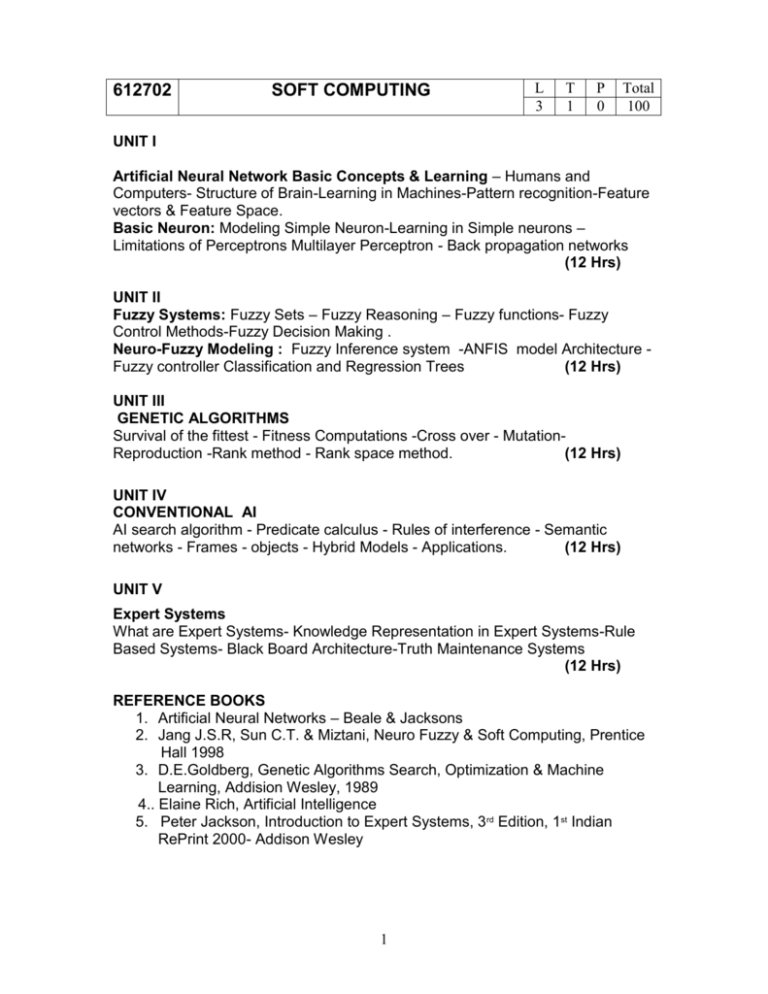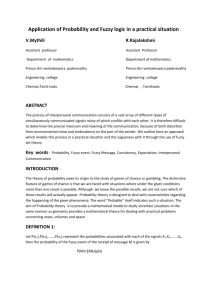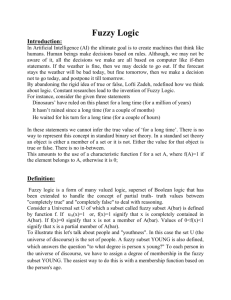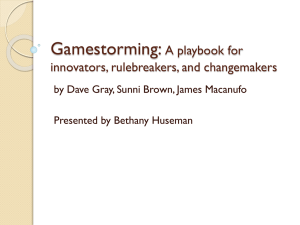612702 Soft Computing
advertisement

612702 SOFT COMPUTING L 3 T 1 P 0 Total 100 UNIT I Artificial Neural Network Basic Concepts & Learning – Humans and Computers- Structure of Brain-Learning in Machines-Pattern recognition-Feature vectors & Feature Space. Basic Neuron: Modeling Simple Neuron-Learning in Simple neurons – Limitations of Perceptrons Multilayer Perceptron - Back propagation networks (12 Hrs) UNIT II Fuzzy Systems: Fuzzy Sets – Fuzzy Reasoning – Fuzzy functions- Fuzzy Control Methods-Fuzzy Decision Making . Neuro-Fuzzy Modeling : Fuzzy Inference system -ANFIS model Architecture Fuzzy controller Classification and Regression Trees (12 Hrs) UNIT III GENETIC ALGORITHMS Survival of the fittest - Fitness Computations -Cross over - MutationReproduction -Rank method - Rank space method. (12 Hrs) UNIT IV CONVENTIONAL AI AI search algorithm - Predicate calculus - Rules of interference - Semantic networks - Frames - objects - Hybrid Models - Applications. (12 Hrs) UNIT V Expert Systems What are Expert Systems- Knowledge Representation in Expert Systems-Rule Based Systems- Black Board Architecture-Truth Maintenance Systems (12 Hrs) REFERENCE BOOKS 1. Artificial Neural Networks – Beale & Jacksons 2. Jang J.S.R, Sun C.T. & Miztani, Neuro Fuzzy & Soft Computing, Prentice Hall 1998 3. D.E.Goldberg, Genetic Algorithms Search, Optimization & Machine Learning, Addision Wesley, 1989 4.. Elaine Rich, Artificial Intelligence 5. Peter Jackson, Introduction to Expert Systems, 3 rd Edition, 1st Indian RePrint 2000- Addison Wesley 1 UNIT – I PART – A 1. What is a neural network? 2. Define pattern recognition 3. What is feature extraction 4. What is linear classifiers?State the limitations of perceptrons 5. List the characteristics of artificial neural networks 6. List out the differences between Supervised and Unsupervised Learning. 7. Draw the structure of a basic neuron 8. What is a perceptron? 9. What is sigmoidal threshold? 10. What is multilayer perceptron 11. Define back propagation rule? 12. What is backpropagation network? 13. List out the advantages of multilayer perceptrons. 14. What are the drawbacks of simple neuron, how is it overcome in multilayer perceptron? 15. List the various applications of multilayer perceptron 16. How multilayer perceptron acts as classifiers? 17. What is generalized delta rule? PART – B PART – B 1. Bring out the difference between human brain and computer 2. Explain the structure of the brain with the learning in biological system 3. Explain the modeling of a single neuron and learning in simple neuron 4. What is pattern classification, explain the various classification techniques 5. What are the limitations of single layer perceptron? Explain with example. 6. Discuss in detail the perceptron learning algorithm and Widrow hoff learning rule. 7. (a) Describe the basic Neuron model. (b) Explain Single Layer Perceptron Learning Algorithm. (c) What are the limitations of single layer perceptron model? 8. (a) Describe the Multilayer Perceptron Network. 2 (b) Explain the Back propagation algorithm 9. What is a multilayer perceptron? Discuss in detail the multilayer perceptron algorithm. 10. What is multilayer perceptron, explain the generalized delta rule or back propagation UNIT – II PART – A 1. What is a fuzzy set? 2. What is a Membership function? 3. Define Triangular MF 4. Define α - cut 5. What is core of a fuzzy set? 6. What is support of a fuzzy set? 7. Define max – product composition. 8. Define Generalized bell MF 9. What is fuzzy complement? 10. Define linguistic variable 11. What is the need of fuzzy controller 12. Draw the ANFIS Architecture? 13. Expand ANFIS 14. What are premise parameters? 15. What are consequent parameters? 16. What are normalized firing strengths? 17. What is fuzzy dynamic system? 18. Define max-min composition. 19. What is Mammdani Fuzzy Inference model 20. What is Tsukamoto Fuzzy Inference model. PART – B 1. Briefly explain the Fuzzy reasoning with example? 2. Discuss the fuzzy control methods with examples? 3 3. Explain the fuzzy decision making with examples? 4. Give a brief note on the following: (a) Classical sets (3) (b) Fuzzy sets (3) (c) One – dimensional Membership Functions (6) 5. (a) Distinguish between crisp and fuzzy sets (6) (b) Explain the various operations performed on fuzzy sets with example.(6) 6. Explain the various membership functions with examples. 7. (a) Distinguish between Crisp and Fuzzy sets. (b) Explain the various operations performed on fuzzy sets with example. 8. (a)What is a Fuzzy Relation? What are the operations performed on a fuzzy relation? (b) What is a Linguistic variable? If MF(Young) = 1/(1+(x/20)4) and MF(Old) = 1/(1+(x-100)6/30), then construct the MF for the following composite terms (i) More of Less old (ii) Extremely old (iii) Young but not too young 9. Explain the various fuzzy membership functions with examples 10. (a) Explain Fuzzy rules and decomposition of these fuzzy rules. (b) Explain the fuzzy reasoning procedure. 11. Explain the overall process taking place in a fuzzy logic controller. 12. (a) Explain the Mammdani, Sugeno and Tsukamoto Fuzzy Inference model. (b) Show how do you convert a Sugeno Fuzzy model to a ANFIS model. 13. (a)What is a Decision Tree? Distinguish between a Classification tree and a Regression Tree. (b) Explain the CART algorithm for Tree Induction. 14. Give an overview of Feedback control system and Neuro-Fuzzy control system. UNIT – III PART – A 1. Define Genitic Algorithm? 2. What is simple crossover? 3. What are the steps in GA? 4. Define Mutation with example 5. Define Inversion with example 4 6. What is meant by reproduction 7. What is a crossover? 8. What are the types of crossover? 9. list the requirements for applying genetic algorithm. 10. List various ways of reproduction in genetic algorithm PART – B 1. Explain the steps of GA with flowchart? 2. Briefly discuss the GA with an example? 3. Explain in detail about the fittest computations? 4. Explain the mutation in GA with example? 5. Explain in detail reproduction and crossover in GA with examples 6. Discuss with examples the various operations of Genetic Algorithm ` UNIT IV 1. Explain the following AI search algorithms (i) Breadth First Search (ii) Depth First or Backtracking Search (iii) Approximate Search 2. (a) Explain about the Language and Semantics used in Artificial Intelligence techniques (b) What is Quantification? Explain the Semantics of Quantifiers. 3. (a) What are Frames and Objects? (b)Explain knowledge representation using semantic networks. 5 6






